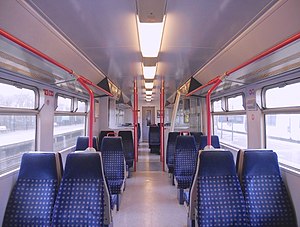British Rail Class 319
| British Rail Class 319 | |
|---|---|

First Capital Connect refreshed Class 319/4 No. 319437 at East Croydon
|
|

The interior of Standard Class accommodation from a First Capital Connect refreshed Class 319/4
|
|
| In service | 1987 – present |
| Manufacturer | BREL York |
| Order number |
|
| Built at | Holgate Road carriage works |
| Family name | BR Second Generation (Mark 3) |
| Constructed | 1987–88, 1990 |
| Entered service | 1987-1990 |
| Refurbishment | 1996-1999 |
| Number built | 86 units |
| Formation |
|
| Diagram |
|
| Fleet numbers |
|
| Capacity |
|
| Operator(s) | |
| Depot(s) | |
| Line(s) served | |
| Specifications | |
| Car body construction | Steel |
| Car length |
|
| Width | 2.82 m (9 ft 3 in) |
| Height | 3.58 m (11 ft 9 in) |
| Doors | Bi-parting sliding, emergency end doors |
| Articulated sections | 4 |
| Wheelbase | 14.170 m (46.49 ft) |
| Maximum speed | 100 mph (161 km/h) |
| Weight | 140.3 t (138.1 long tons; 154.7 short tons) |
| Axle load |
|
| Traction motors | 4 × GEC G315BZ |
| Power output | 4 × 247.5 kW (331.9 hp) |
| Train heating | Electric |
| Electric system(s) | |
| Current collection method |
|
| UIC classification | 2'2'+Bo'Bo'+2'2'+2'2' |
| Bogies |
|
| Braking system(s) | Westinghouse 3 step friction brake,disc,air (Westcode) |
| Safety system(s) | |
| Coupling system | Tightlock |
| Multiple working | |
| Headlight type | Fluorescent |
| Track gauge | 1,435 mm (4 ft 8 1⁄2 in) standard gauge |
The British Rail Class 319 is a dual-voltage electric multiple unit train capable of operating on 25 kV AC from overhead wires or 750 V DC from a third rail. They were built by BREL York for use on north-south cross-London services.
Built in two batches in 1987–88 and 1990, the units were primarily used on the then-new Thameslink service operating from Bedford to Brighton and various other destinations south of London. The majority of the fleet remained in use on the Thameslink route after its reshaping and privatisation in 1997. Some of the fleet was also used on various other services operating out of London Victoria, including flagship expresses to Brighton.
Since delivery of new rolling stock for Thameslink services commenced in 2015, a number of Class 319 units have been redeployed for use on other operators' services, including in the North West of England.
In the 1980s, there were plans for a rail service that would link Bedford and Brighton. These services would cross London in a north-south direction, and thus became the first passenger route for many years to cross London from north to south. These services were branded Thameslink by Network SouthEast, which operated the services.
As the Thameslink service was to use a route with 25 kV AC OHLE north of Farringdon and along the branch to Moorgate, and 750 V DC third-rail electrification south of Farringdon, the Class 319 trains were built with dual-voltage capabilities, making them very versatile. They were also the first British Rail units to use modern thyristor control in place of a camshaft and resistor bank.
...
Wikipedia
